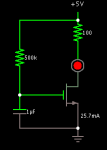GooeyGus
0
- Joined
- Mar 8, 2008
- Messages
- 2,669
- Points
- 48
Hi guys... I was curious about how one could make a diode 'fade' on to full power over the course of about 1 - 2 seconds. I'm guessing one could do it with some sort of capacitor... but I tried wiring one up a couple different ways and it didn't' seem to work. I think it would be a cool effect, and may also prevent severely over-driven diodes from failing due to the harshness of start-up.
Any ideas?
Any ideas?






